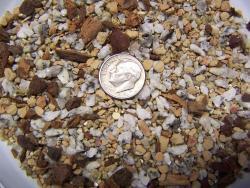I make ALL of my own media and have been helping others online to overcome problems related to excess water retention. You can search online to see how much of an impact it's made on the container gardening community by doing a google search using
Al 5-1-1 mix as the searchwords.
I actually started talking about 2 different mixes in 2004. One is what others eventually named the 5-1-1 mix and the other is 'the gritty mix'. If you did the search, I hope it makes you want to extend me at least some credibility, if not, I'll try to earn it because I do enjoy helping.
Most commercially prepared media are too water-retentive and inherently limiting because of that property, i.e. if you're the gardener who wants to offer plants the best opportunity to realize as much of their genetic potential as possible. BTW - I don't sell anything and all I push is a concept. Water retention is primarily driven by particle size, and the finer the particles, the greater the water-retention. In order to reap the rewards offered by fast-draining and highly aerated media, you'll need to start with a large fraction of coarse material. The 5:1:1 mix uses pine bark as the base.
By volume
5 parts pine bark screened dust to 3/8" (1/2" is ok if you can't find a 3/8" screen)
1 part sphagnum peat
1 part coarse or medium perlite
an appropriate measure of dolomitic (garden) lime, volume depending on batch size
Best if the mix sits moist for 2 weeks so the lime completes the reaction phase if you're planting anything susceptible to BER
That's it. The recipe is a starting point, and you can adjust the water retention by adjusting the amount of peat added.
I can tell you all the scientific stuff about water's adhesive and cohesive properties that work in concert as capillarity, the force of which can be greater than gravity and can cause a table of water to perch in the soil above the container bottom or above a drainage layer if you want the particulars. If there's interest, I'll start a new thread.
It's important to know, when you're looking for drainage and aeration, you must control the volume of fine particles. There is a threshold proportion of fine:coarse material you should understand. If you have a quart jar 1/4 full of sand, and you want to increase air porosity, how much porosity will a handfull of BBs add. You can see in your mind's eye that the jar with BBs has wonderful air pores between the BBs, so adding them to the sand should increase air porosity, right? In reality, it increases the volume of the medium but the actual volume of air porosity is unchanged. Therefore, o/a air porosity DECREASES, and, it continues to decrease until you reach the threshold proportion where there is exactly enough sand to fill all the spaces between the BBs. From that point forward, as you add more BBs the o/a air porosity increases dramatically. This is why you need a large fraction of coarse ingredients if you want the most from the soil.
You'll need to water more often, but your plants will love it. You might choose to go for the convenience of longer watering intervals, but the longer the watering intervals, the longer that saturated layer of soil at the bottom of the pot hangs around limiting root function and sapping potential. There's no judgment to be made about which way someone chooses to go, but at least you'll understand there is a penalty to be paid for media that offer extended watering intervals.

5:1:1 mix with objects for size perspective

Gritty mix - I have over 200 plants in this, and it's the most productive medium I've been able to come up with after 30 years of tinkering.
Al
 5:1:1 mix with objects for size perspective
5:1:1 mix with objects for size perspective Gritty mix - I have over 200 plants in this, and it's the most productive medium I've been able to come up with after 30 years of tinkering.
Gritty mix - I have over 200 plants in this, and it's the most productive medium I've been able to come up with after 30 years of tinkering.